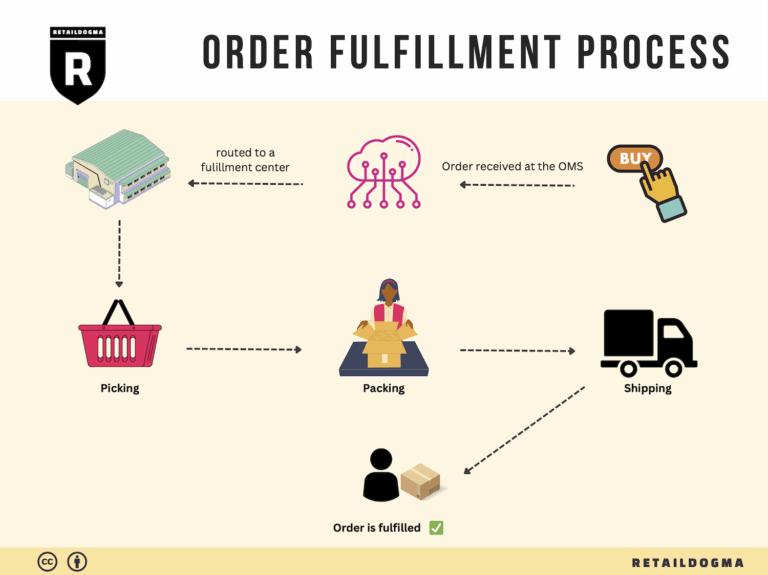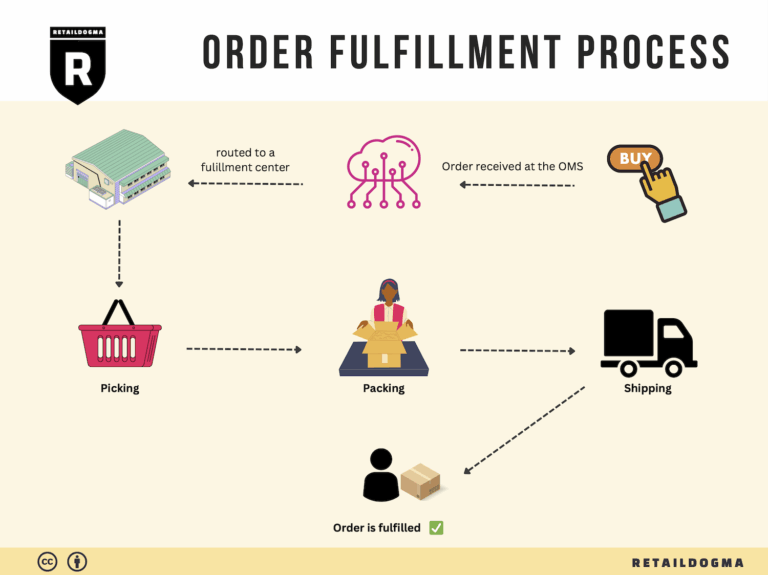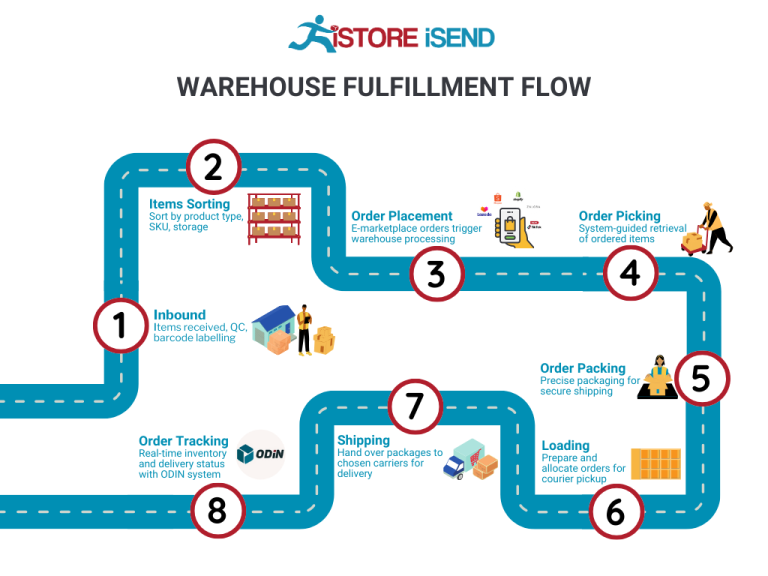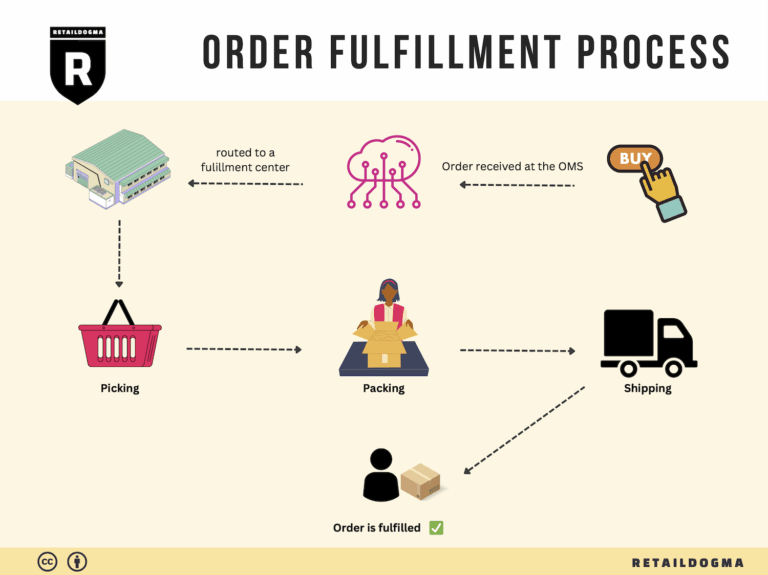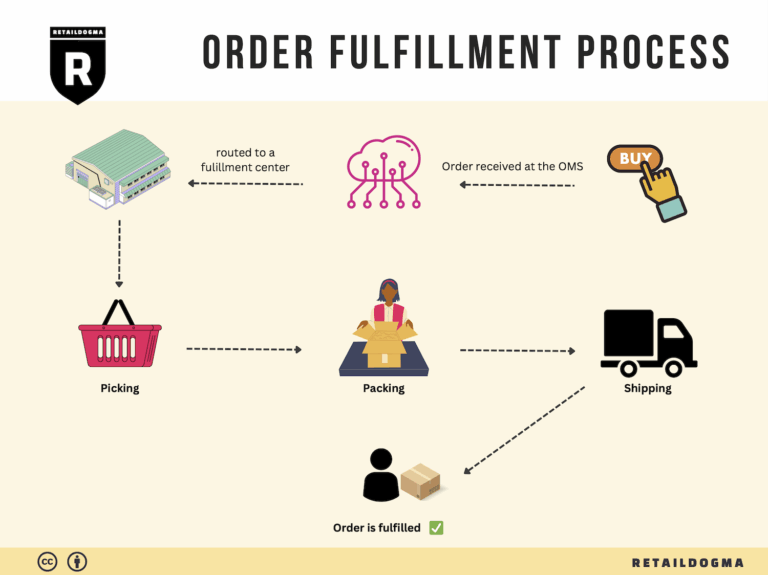What Is A Fulfillment Center? A Complete Guide (2025)
What is E-commerce Fulfillment? An Introduction for Growing Businesses
Understanding the Fulfillment Process
As an e-commerce business owner, you may find yourself overwhelmed with the complexities of packing and shipping orders. Managing inventory, ensuring timely deliveries, and maintaining customer satisfaction can quickly become daunting tasks. This is where e-commerce fulfillment comes into play, serving as the backbone of your operations. Simply put, fulfillment is the process of getting a product into the hands of your customer, encompassing everything from inventory management to shipping logistics.
The Fulfillment Landscape
In the rapidly evolving world of e-commerce, understanding the various fulfillment models is crucial for scaling your business effectively. This guide will delve into two primary fulfillment strategies: Third-Party Logistics (3PL) and Fulfillment by Amazon (FBA). Each model offers unique advantages and challenges, allowing you to choose the best fit based on your operational needs and growth goals.
Core Fulfillment Services
Our exploration will cover the core services associated with e-commerce fulfillment. These services include inventory storage, order processing, picking and packing, shipping, and returns management. Each component plays a critical role in ensuring that your products reach customers quickly and efficiently, directly impacting your business’s reputation and customer loyalty.
Choosing the Right Partner
Selecting the right fulfillment partner is a pivotal decision that can influence your operational efficiency and bottom line. We will provide practical tips on what to look for in a fulfillment partner, including technology integration, scalability, reliability, and customer service. Understanding these factors will empower you to make informed decisions that align with your business objectives.
Navigating Pricing
Pricing is often a significant concern for growing businesses, and our guide will outline the different pricing structures you may encounter in the fulfillment space. From per-order fees to storage costs, we will break down the potential expenses, helping you to anticipate and budget for fulfillment costs effectively.
Empowering Your Business Decisions
Ultimately, this guide aims to empower you with the knowledge needed to make smart decisions about your logistics. By understanding the intricacies of e-commerce fulfillment and the options available, you can streamline your operations, enhance customer satisfaction, and position your business for sustainable growth. Whether you are just starting or looking to scale, the insights provided here will serve as a valuable resource in your e-commerce journey.
What You’ll Learn In This Guide
- What is E-commerce Fulfillment? An Introduction for Growing Businesses
- The Order Fulfillment Process: From ‘Buy’ Button to Customer’s Door
- Comparing Fulfillment Models: In-House vs. 3PL vs. Dropshipping
- A Deep Dive into Amazon FBA: Pros, Cons, and Who It’s For
- Core Services Offered by Fulfillment Centers
- How to Choose a Fulfillment Partner: A 6-Point Checklist
- Understanding Fulfillment Pricing: A Breakdown of Common Fees
- Frequently Asked Questions (FAQs) about Fulfillment
- Conclusion: Is Outsourcing Fulfillment the Right Move for Your Business?
- Important Disclaimer
The Order Fulfillment Process: From ‘Buy’ Button to Customer’s Door
1. Receiving Inventory
The order fulfillment process begins with receiving inventory at the fulfillment center. This step involves checking incoming shipments against purchase orders to ensure accuracy in quantity and quality. Each product is assigned a Stock Keeping Unit (SKU), a unique identifier that helps in tracking inventory throughout the warehouse.
Importance: Proper receiving procedures are crucial as they set the foundation for efficient inventory management. If discrepancies occur at this stage, they can lead to inventory inaccuracies, which may result in stockouts or overstock situations, ultimately affecting customer satisfaction.
Key Term: SKU (Stock Keeping Unit) – A unique identifier for each distinct product and service that can be purchased.
2. Warehouse Storage
Once the inventory is received and verified, it is stored in designated areas within the fulfillment center. The Amazon MQY1 Fulfillment Center, for example, utilizes advanced storage solutions that maximize space and efficiency, such as automated storage systems and robotic shelving units.
Importance: Effective warehouse storage is vital for maintaining organization and facilitating quick access to products. By optimizing the layout and storage methods, businesses can reduce the time it takes to locate and retrieve items, thus improving overall operational efficiency.
Key Term: Bin Location – A specific area within the warehouse where a product is stored, allowing for easy retrieval during the picking process.
3. Order Picking
When a customer places an order, the next step is order picking. This involves retrieving the specific items from their storage locations based on a pick list generated by the system. Advanced fulfillment centers like MQY1 often employ a combination of human workers and robotic systems to enhance picking speed and accuracy.
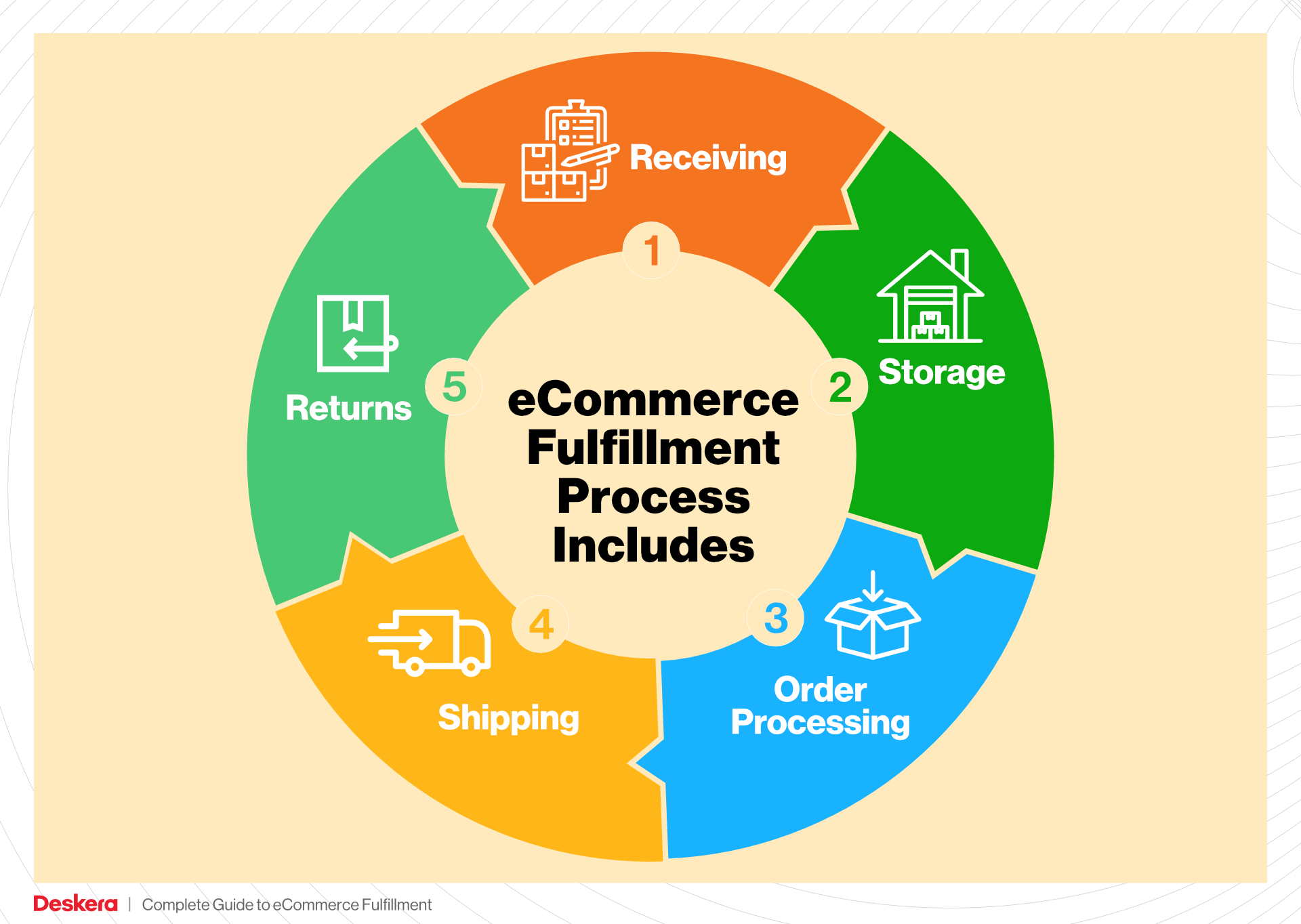
Importance: The efficiency of the order picking process directly impacts the speed of order fulfillment. Quick and accurate picking ensures that customers receive their orders promptly, which is essential in today’s competitive e-commerce landscape.
Key Term: Pick List – A document or digital display that lists the items to be picked for a specific order, including their bin locations.
4. Order Packing
After items have been picked, they proceed to the packing station. Here, products are carefully packed into boxes or totes, often using automated packing machines that help to minimize material waste and enhance packing speed. Employees ensure that the right items are packed securely to prevent damage during transit.
Importance: Order packing is a critical step in the fulfillment process. Proper packing not only protects items during shipping but also contributes to a positive unboxing experience for customers. A well-packed order reflects the brand’s commitment to quality and care.
Key Term: Packing Slip – A document included in the package that outlines the items enclosed, serving as a receipt for the customer.
5. Shipping & Delivery
The final step in the order fulfillment process is shipping and delivery. Once orders are packed, they are labeled and sorted based on their destination. The MQY1 Fulfillment Center leverages advanced logistics networks, including Amazon’s own delivery services and partnerships with carriers, to ensure timely delivery.
Importance: Efficient shipping and delivery are paramount to customer satisfaction. Fast and reliable delivery services enhance the overall shopping experience and can lead to repeat business. In an era where consumers expect rapid delivery times, optimizing this step can be a significant competitive advantage.
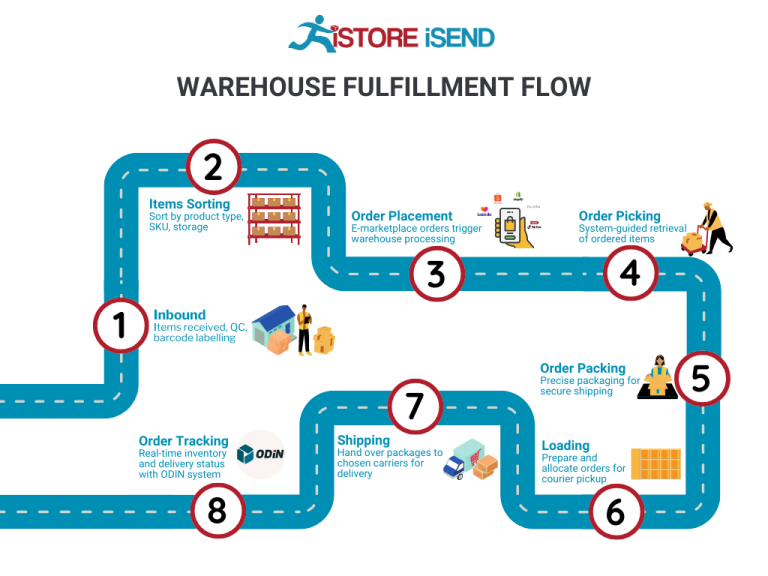
Key Term: Last-Mile Delivery – The final step of the delivery process where the package is transported from a distribution center to the customer’s doorstep, often considered the most critical phase in logistics.
By understanding each step of the order fulfillment process, e-commerce business owners, operations managers, and entrepreneurs can identify areas for improvement and implement strategies to enhance efficiency and customer satisfaction. Leveraging the capabilities of advanced fulfillment centers like Amazon MQY1 can provide significant advantages as businesses scale their operations.
Comparing Fulfillment Models: In-House vs. 3PL vs. Dropshipping
Fulfillment Model Comparison
| Model | Who Handles Inventory | Best For (Business Stage) | Key Advantage | Key Disadvantage |
|---|---|---|---|---|
| In-House Fulfillment | The business itself | Established businesses | Greater control over inventory and processes | High overhead costs and resource requirements |
| Third-Party Logistics (3PL) | A third-party provider | Growing businesses | Scalability and reduced operational burden | Less control over fulfillment processes |
| Dropshipping | Supplier or manufacturer | Startups and small businesses | Low startup costs and minimal risk | Lower profit margins and reliance on suppliers |
In-House Fulfillment
In-house fulfillment involves managing the entire logistics process within the business itself. This model is typically employed by established businesses that have sufficient resources, including space, workforce, and technology, to handle inventory storage, order processing, and shipping. The primary advantage of in-house fulfillment is the level of control it affords the business. Companies can customize their operations to align closely with their brand values, ensuring that every aspect of the customer experience is meticulously managed. Additionally, this model can lead to faster order processing times since all activities occur under one roof.
However, the in-house model comes with significant drawbacks, notably high overhead costs associated with staffing, warehousing, and technology investments. These costs can become burdensome, especially for smaller businesses or those looking to scale rapidly. Additionally, maintaining a large inventory can lead to increased risk if products do not sell as expected, tying up capital that could be utilized elsewhere in the business.
Third-Party Logistics (3PL)
Third-party logistics (3PL) providers offer outsourced logistics services, allowing businesses to leverage external expertise for their warehousing and distribution needs. This model is ideal for growing businesses that need to scale quickly without the capital investment required for in-house fulfillment. By partnering with a 3PL, companies can benefit from established infrastructure and systems that can handle everything from inventory management to shipping and returns.
One of the key advantages of using a 3PL is the scalability it offers. Businesses can quickly adjust their logistics capabilities in response to market demands without the associated overhead of maintaining their own warehousing facilities. Additionally, 3PLs often bring technological advantages, such as sophisticated inventory management systems and advanced shipping solutions, enhancing operational efficiency.
However, outsourcing fulfillment also presents challenges. The primary disadvantage is the reduced control over the logistics process. Businesses may face issues with quality assurance, shipping errors, or delays that can impact customer satisfaction. Furthermore, reliance on a third party can create communication gaps, making it difficult to ensure that the logistics operations align perfectly with the business’s goals and standards.
Dropshipping
Dropshipping is a fulfillment model where the retailer does not keep products in stock but instead transfers customer orders directly to a supplier or manufacturer, who then ships the products directly to the customer. This model is particularly suited for startups and small businesses with limited capital, as it eliminates the need for significant upfront investment in inventory.
The primary advantage of dropshipping is the low barrier to entry. Entrepreneurs can launch their e-commerce businesses without the risks associated with holding inventory, making it an appealing option for those testing new products or markets. Additionally, this model allows for a wide range of products to be offered without the overhead of warehousing, enabling businesses to pivot quickly based on consumer demand.
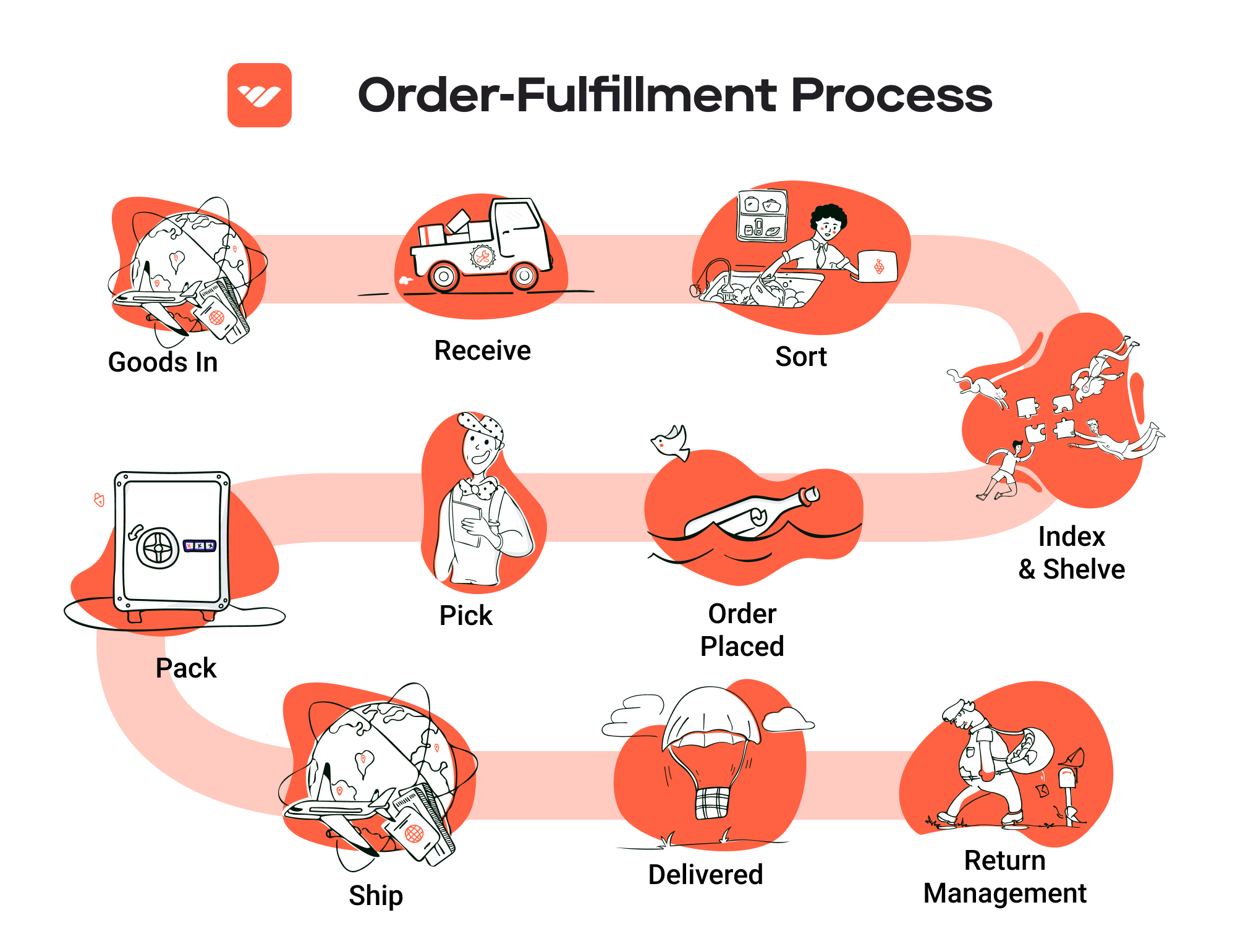
However, dropshipping also comes with notable disadvantages. Profit margins are typically lower compared to other fulfillment models, as retailers must account for the supplier’s markup. Furthermore, businesses relying on dropshipping are at the mercy of their suppliers regarding inventory levels and shipping times. This can lead to inconsistent customer experiences, with potential issues such as stockouts, shipping delays, and quality control problems, all of which can harm a brand’s reputation.
Conclusion
Choosing the right fulfillment model is a critical decision for e-commerce business owners, as it can significantly impact operational efficiency, customer satisfaction, and overall profitability. In-house fulfillment offers control but at a higher cost, 3PL provides scalability with some loss of control, and dropshipping minimizes risk but can lead to lower profit margins. Understanding the nuances of each model is essential for making an informed choice that aligns with business objectives and growth strategies.
A Deep Dive into Amazon FBA: Pros, Cons, and Who It’s For
Understanding Fulfillment by Amazon (FBA)
Fulfillment by Amazon (FBA) is a service offered by Amazon that allows sellers to store their products in Amazon’s fulfillment centers. Amazon takes care of storage, packaging, shipping, and customer service on behalf of the sellers, enabling them to focus on other aspects of their business. The process is streamlined: sellers simply send their products to Amazon, and when a customer places an order, Amazon handles the logistics.
How FBA Works
-
Setting Up Your FBA Account: Sellers must first create an Amazon seller account and enroll in the FBA program. This involves providing necessary business information and agreeing to Amazon’s terms.
-
Product Preparation and Shipping: Sellers prepare their products according to Amazon’s guidelines, which include packaging and labeling requirements. Once prepared, the products are shipped to one or more of Amazon’s fulfillment centers.
-
Storage: Upon arrival at the fulfillment center, Amazon stores the products in its warehouse. The company utilizes advanced technology and automation to manage inventory efficiently.
-
Order Fulfillment: When a customer orders a product, Amazon picks, packs, and ships it directly to the customer. This process is typically very fast, leveraging Amazon’s extensive logistics network.
-
Customer Service and Returns: Amazon also handles customer inquiries and returns for FBA products, offering a seamless experience for both sellers and customers.
Pros of Using FBA
1. Prime Eligibility
One of the most significant advantages of FBA is that products become eligible for Amazon Prime. This means that Prime members can receive free two-day shipping on your products, which can significantly enhance sales potential. Prime customers tend to spend more and are more likely to choose Prime-eligible items over non-eligible ones.
2. Customer Trust
Selling through FBA enhances credibility. Customers often trust Amazon’s fulfillment and customer service more than third-party sellers. This trust can lead to higher conversion rates, as buyers feel more secure purchasing items backed by Amazon’s reputation.
3. Multi-Channel Fulfillment
FBA isn’t limited to Amazon alone. Sellers can utilize FBA for orders from other platforms, such as their own websites or eBay. This multi-channel fulfillment capability allows for a unified inventory management system, simplifying logistics for sellers who operate across various sales channels.
4. Scalability
FBA provides an opportunity for businesses to scale without the complexities of warehousing and logistics management. As demand increases, sellers can send more inventory to Amazon without worrying about increasing their operational overhead.
5. Streamlined Operations
By outsourcing fulfillment to Amazon, sellers can focus on marketing, product development, and customer engagement rather than logistics. This can lead to more efficient operations and ultimately better business outcomes.
Cons of Using FBA
1. High Fees
While FBA offers many benefits, it also comes with substantial fees. Sellers are charged for storage, fulfillment, and additional services. These costs can eat into profit margins, particularly for low-cost items. It is crucial for sellers to carefully calculate these fees to determine if FBA is economically viable for their products.
2. Strict Inventory Rules
Amazon has stringent policies regarding inventory management. Sellers must adhere to guidelines on product labeling, packaging, and preparation. Non-compliance can lead to additional fees or even the refusal of inventory. This can be a significant hurdle for sellers who are new to the platform or those with varying product lines.
3. Commingling Risks
FBA products from different sellers may be stored together, known as commingling. This can lead to issues if a seller’s inventory is mixed with defective or returned items from other sellers. If customers receive the wrong item or a damaged product, it can negatively impact the seller’s ratings and customer satisfaction.
4. Loss of Control
Using FBA means handing over control of order fulfillment and customer service to Amazon. While this can be beneficial, it also means that sellers must adhere to Amazon’s policies and procedures, which may not always align with their business practices.
5. Complexity in Returns
While Amazon handles returns, the process can be complex for sellers, especially when dealing with returns from non-Amazon channels. Sellers may find themselves navigating multiple return policies and customer service inquiries, which can be time-consuming.
Who is FBA Best For?
Fulfillment by Amazon is ideally suited for small to medium-sized e-commerce businesses looking to scale their operations without the overhead of managing logistics. It is particularly beneficial for:
- New Sellers: Those who are just starting and want to leverage Amazon’s infrastructure to gain visibility and credibility.
- High-Volume Sellers: Businesses with a significant volume of sales that can benefit from Amazon’s logistics capabilities and faster shipping options.
- Brands Seeking Prime Eligibility: Sellers who want to tap into the Prime customer base and enhance their product visibility.
- Multi-Channel Retailers: Businesses that sell across various platforms and want a unified logistics solution.
In summary, FBA provides a robust solution for e-commerce businesses looking to grow while minimizing the challenges associated with order fulfillment and logistics. However, sellers must weigh the benefits against the costs and operational complexities to determine if it aligns with their business goals.
Core Services Offered by Fulfillment Centers
Inventory Management & Warehousing
Inventory management is a critical aspect of e-commerce operations, and fulfillment centers like Amazon MQY1 excel in this area. These centers provide extensive warehousing capabilities designed to efficiently store and manage inventory. With advanced technology and automation, such as sophisticated inventory tracking systems and robotics, fulfillment centers ensure that products are stored optimally and can be easily accessed when orders are placed.
Benefits to E-commerce Businesses:
1. Real-time Inventory Tracking: Fulfillment centers employ inventory management software that tracks stock levels in real time. This helps businesses avoid stockouts or overstock situations, ensuring that customer demand is consistently met without unnecessary carrying costs.
2. Space Optimization: Large-scale warehouses, such as MQY1, are designed to utilize vertical space effectively, allowing businesses to store a greater volume of products without needing additional facilities. This translates to lower overhead costs and improved inventory turnover rates.
3. Scalability: As businesses grow, their inventory needs change. Fulfillment centers provide the flexibility to scale storage space up or down based on demand, allowing e-commerce businesses to adapt quickly without the burden of long-term leases or investments in additional infrastructure.
Pick and Pack Services
Pick and pack services are essential for e-commerce operations, where speed and accuracy are paramount. Fulfillment centers streamline the order fulfillment process by efficiently picking items from inventory and packing them for shipment. At facilities like MQY1, automation and robotics enhance these processes, significantly reducing the time it takes to get orders out the door.
Benefits to E-commerce Businesses:
1. Increased Order Accuracy: Automated systems and trained personnel minimize human error during the picking process, leading to higher accuracy in order fulfillment. This results in fewer returns and improved customer satisfaction.
2. Faster Turnaround Times: Fulfillment centers are equipped with advanced technologies, including conveyor belts and robotic systems, that speed up the picking and packing process. This allows businesses to offer faster shipping options, which is a significant competitive advantage in the e-commerce landscape.
3. Customizable Packing Options: Fulfillment centers often provide various packing solutions, including branded packaging and special inserts. This flexibility allows businesses to enhance their branding and improve the unboxing experience for customers.
Kitting and Assembly
Kitting and assembly involve the grouping of individual products into a single package or kit, which is particularly beneficial for businesses that offer bundled products or require assembly before shipping. Fulfillment centers like MQY1 have the capability to perform these services efficiently, ensuring that products are packaged correctly before they reach the customer.
Benefits to E-commerce Businesses:
1. Streamlined Operations: By outsourcing kitting and assembly to fulfillment centers, businesses can focus on core activities such as marketing and product development rather than logistics. This streamlining leads to enhanced operational efficiency and productivity.
2. Enhanced Product Offerings: Kitting allows businesses to create attractive product bundles that can increase average order value. Fulfillment centers can quickly assemble these kits, allowing businesses to respond to market trends and customer preferences more effectively.
3. Quality Control: Fulfillment centers often have quality control measures in place to ensure that all assembled kits meet the required standards. This reduces the risk of customer complaints and returns, enhancing brand reputation.
Returns Management (Reverse Logistics)
Returns management is a crucial component of the e-commerce landscape, as customers increasingly expect hassle-free return processes. Fulfillment centers play a vital role in managing returns efficiently, ensuring that returned items are processed quickly and accurately.
Benefits to E-commerce Businesses:
1. Efficient Processing: Fulfillment centers streamline the returns process by quickly inspecting and restocking returned items. This minimizes downtime and allows businesses to recover inventory swiftly, reducing potential losses.
2. Customer Satisfaction: A smooth returns process enhances customer satisfaction and loyalty. Fulfillment centers can provide pre-paid return labels and easy instructions, making it simple for customers to return items, which can lead to increased trust and repeat purchases.
3. Data Insights: Fulfillment centers track return reasons and patterns, providing valuable insights into customer behavior. This data can inform product improvements, marketing strategies, and inventory management, ultimately leading to better business decisions.
In conclusion, the core services offered by fulfillment centers like Amazon MQY1 are integral to the success of e-commerce businesses. From inventory management and pick and pack services to kitting and returns management, these services enhance operational efficiency, improve customer satisfaction, and support scalability. By leveraging the capabilities of fulfillment centers, businesses can focus on growth while ensuring that their logistics operations run smoothly.
How to Choose a Fulfillment Partner: A 6-Point Checklist
Location & Warehouse Network
Importance:
The location of your fulfillment partner’s warehouses can significantly impact shipping times and costs. A partner with warehouses strategically located near your primary customer bases can help reduce shipping costs and improve delivery speeds.
Questions to Ask:
1. Where are your warehouses located, and how do these locations align with my target markets?
2. Do you have a network of fulfillment centers that can handle my distribution needs?
3. What is your typical shipping time to my primary regions?
Technology & Integrations
Importance:
The technology a fulfillment partner employs can enhance efficiency and transparency in your supply chain. A partner that offers robust technology solutions can help streamline order processing, inventory management, and tracking.
Questions to Ask:
1. What warehouse management system (WMS) do you use, and how does it integrate with my existing e-commerce platform?
2. Do you provide real-time inventory tracking and reporting features?
3. How do you handle order updates and customer notifications?
Specializations (e.g., cold storage, oversized items)
Importance:
Depending on your product offerings, you may require specific storage conditions or handling capabilities. Ensuring that your fulfillment partner has the right specializations can prevent issues with product quality and compliance.
Questions to Ask:
1. Do you have experience handling products similar to mine, such as perishable goods or oversized items?
2. What specific storage conditions do you offer (e.g., temperature-controlled environments)?
3. Can you accommodate unique packaging or handling requirements for my products?
Scalability & Capacity
Importance:
As your business grows, your fulfillment needs will likely change. A partner that can scale with you—both in capacity and service offerings—can help you avoid disruptions as you expand.
Questions to Ask:
1. How do you handle seasonal fluctuations or unexpected surges in order volume?
2. What are your capabilities for scaling up operations, and how quickly can you do so?
3. Can you provide examples of how you’ve successfully scaled for other clients?
Pricing and Contracts
Importance:
Understanding pricing structures and contract terms is crucial for maintaining profitability. Transparency in pricing helps avoid unexpected costs and ensures that you can budget effectively.
Questions to Ask:
1. What are your pricing models (e.g., per order, per item, monthly fees), and what services are included?
2. Are there any hidden fees or surcharges I should be aware of?
3. What are the terms of your contract, and is there flexibility for renegotiation as my business evolves?
Customer Support & Reviews
Importance:
Reliable customer support can make a significant difference in resolving issues quickly and maintaining a smooth operation. Additionally, reviews and testimonials can provide insight into a partner’s reliability and service quality.
Questions to Ask:
1. What support channels do you offer (e.g., phone, email, chat), and what are your response times?
2. Can you provide references or case studies from current or past clients?
3. How do you handle disputes or issues that arise, and what is your process for resolution?
Conclusion
Choosing the right fulfillment partner is a critical decision that can influence your business’s success. By carefully evaluating potential partners against this checklist, you can make informed choices that align with your operational needs and growth ambitions. Always ensure that you engage in thorough discussions and negotiations to clarify any uncertainties before committing to a partnership. This diligence will help you build a strong foundation for your logistics and fulfillment operations as you scale your e-commerce business.
Understanding Fulfillment Pricing: A Breakdown of Common Fees
Initial Setup Fees
Initial setup fees are one-time costs associated with establishing your account with a fulfillment center like Amazon MQY1. These fees typically cover the onboarding process, which may include account setup, integration with your e-commerce platform, and any necessary training for your staff.
The calculation of these fees can vary significantly based on the complexity of your needs. For instance, if you require custom software integration or specialized training sessions, the initial setup fees may be higher. Businesses should inquire about the specifics of what the setup fee includes to ensure they understand the full scope of the services being provided.
Receiving Fees
Receiving fees are charged when inventory is delivered to the fulfillment center. These fees cover the costs associated with unloading, inspecting, and storing your products.
Typically, receiving fees are calculated per pallet or per unit. For example, if you send a shipment of 10 pallets, you may be charged a flat rate per pallet received. The fee structure can vary based on the type of product and the volume being received. It’s crucial to factor in these costs when planning inventory shipments to avoid unexpected expenses.
Storage Fees (per pallet/bin)
Storage fees are charged for the space your inventory occupies within the fulfillment center. These fees can be calculated on a monthly basis, either per pallet or per bin, depending on how your products are stored.
For instance, if you have 5 pallets of products stored for a month, and the storage fee is $20 per pallet, you would incur a monthly storage cost of $100. It’s important to note that some fulfillment centers may also have different rates for long-term storage, which usually applies to items that remain unsold for an extended period. Businesses should monitor their inventory turnover rates to minimize long-term storage fees.
Pick & Pack Fees (per item/order)
Pick & pack fees are charged for the labor involved in selecting items from storage and packaging them for shipment. This fee can be structured in several ways, typically either per item or per order.
For example, if the fee is $1 per item and a customer orders three items, the total pick & pack fee would be $3. Alternatively, some fulfillment centers may charge a flat fee per order, regardless of the number of items. Understanding this fee structure is essential for pricing your products accurately, as it directly impacts your overall fulfillment costs.
Shipping Fees
Shipping fees encompass the costs of transporting your products from the fulfillment center to the customer. These fees can vary based on several factors, including the shipping method chosen, the destination, and the weight or dimensions of the package.
Fulfillment centers often provide multiple shipping options, such as standard, expedited, or same-day delivery, each with its own associated costs. The calculation may be based on weight, dimensions, and distance. For example, shipping a 10-pound package across the country may incur a different fee than shipping the same package locally. It’s advisable to compare shipping options and negotiate with fulfillment centers for better rates, especially if you anticipate high shipping volumes.
Conclusion: Tips for Getting an Accurate Quote
When seeking an accurate quote for fulfillment services, consider the following tips:
-
Be Detailed in Your Requirements: Provide the fulfillment center with comprehensive details about your inventory, expected order volume, and specific needs. This clarity helps them provide a more accurate quote.
-
Ask About Fee Structures: Inquire about how each fee is calculated and what factors influence them. Understanding the fee structures will help you budget more effectively.
-
Negotiate Terms: Don’t hesitate to discuss pricing with the fulfillment center. Depending on your projected volume, you may be able to negotiate lower rates or more favorable terms.
-
Consider All Potential Costs: Ensure you consider all possible fees, including hidden costs like long-term storage or seasonal rate changes.
-
Review Contract Terms: Before signing, carefully review the contract terms to ensure you understand all fees and conditions related to service changes or additional costs.
By following these guidelines, e-commerce business owners can better navigate fulfillment pricing and make informed decisions that contribute to their overall growth and efficiency.
Frequently Asked Questions (FAQs) about Fulfillment
1. What is the Amazon MQY1 Fulfillment Center?
The Amazon MQY1 Fulfillment Center, located in Mount Juliet, Tennessee, is one of Amazon’s largest and most advanced warehouses. Spanning 3.6 million square feet, it specializes in storing, packing, and shipping a wide range of products, primarily smaller items. The facility features cutting-edge automation, including robotic systems, to enhance efficiency and speed in order processing and fulfillment.
2. How does the MQY1 Fulfillment Center utilize automation?
Automation at the MQY1 Fulfillment Center is primarily achieved through the use of robotic systems that assist in lifting and transporting goods. This technology reduces the physical strain on employees by minimizing repetitive motions, thereby increasing safety and efficiency. The center employs over 3,000 workers who collaborate with these robots, allowing for streamlined sorting and packing processes.
3. What is the difference between a warehouse and a fulfillment center?
A warehouse primarily focuses on storage, while a fulfillment center is designed for order processing and shipping. Fulfillment centers are equipped with advanced technology and logistics systems to manage inventory, process orders, and ensure timely delivery to customers. In contrast, warehouses typically do not engage in the order fulfillment process and may only serve as a holding space for products.
4. What types of products are processed at the MQY1 Fulfillment Center?
The MQY1 Fulfillment Center specializes in smaller products, with maximum dimensions of 18 x 18 inches. This includes a wide array of items such as electronics, household goods, and small retail products. The facility is optimized for handling high volumes of these types of products efficiently.
5. What safety measures are in place at the MQY1 Fulfillment Center?
Safety at the MQY1 Fulfillment Center is a top priority, with various measures implemented to protect employees. These include the use of robotic systems to perform heavy lifting, ergonomic workstations, and regular safety training. Additionally, employees participate in wellness activities to prevent injuries associated with repetitive movements, ensuring a safer working environment.
6. How much do fulfillment services cost?
The cost of fulfillment services can vary widely based on several factors, including the size and weight of the products, order volume, and specific services required (e.g., storage, packing, shipping). Typically, fulfillment fees may include a per-order fee, storage fees based on the volume of goods stored, and shipping costs. It’s essential for businesses to evaluate their specific needs and request quotes from fulfillment providers to obtain accurate pricing.
7. What is a 3PL, and how does it relate to fulfillment?
A 3PL, or third-party logistics provider, is a company that offers outsourced logistics services, including warehousing, fulfillment, and transportation. Businesses often partner with 3PLs to manage their supply chain and fulfillment needs, allowing them to focus on core operations. The Amazon MQY1 Fulfillment Center can be considered a type of 3PL, as it provides comprehensive services for order fulfillment on behalf of various sellers.
8. How does Amazon ensure timely delivery from the MQY1 Fulfillment Center?
Amazon employs sophisticated logistics and inventory management systems at the MQY1 Fulfillment Center to streamline operations and ensure timely delivery. This includes real-time inventory tracking, automated picking and packing processes, and optimized shipping routes. The combination of technology and a well-trained workforce enables Amazon to meet its commitment to fast delivery times.
9. Can businesses sell their products through the MQY1 Fulfillment Center?
Yes, businesses can utilize Amazon’s fulfillment services, including the MQY1 Fulfillment Center, to sell their products on the Amazon marketplace. By enrolling in Amazon FBA (Fulfillment by Amazon), sellers can send their products to the MQY1 center, where they will be stored, packed, and shipped directly to customers. This service allows sellers to leverage Amazon’s extensive logistics network.
10. What are the benefits of using the MQY1 Fulfillment Center for e-commerce businesses?
Using the MQY1 Fulfillment Center offers numerous benefits for e-commerce businesses, including:
– Scalability: Ability to handle fluctuating order volumes without the need for additional infrastructure.
– Speed: Access to Amazon’s rapid shipping capabilities, enhancing customer satisfaction.
– Efficiency: Advanced automation reduces handling time and minimizes errors.
– Cost-Effectiveness: By outsourcing fulfillment, businesses can lower overhead costs associated with warehousing and staffing.
– Focus on Growth: Allows businesses to concentrate on marketing, product development, and customer service while Amazon handles logistics.
Conclusion: Is Outsourcing Fulfillment the Right Move for Your Business?
Evaluating the Benefits of Outsourcing Fulfillment
Outsourcing your fulfillment operations can be a transformative decision for your e-commerce business. By leveraging a dedicated fulfillment service, you can save significant time and resources that can be redirected towards scaling your business. This allows you to focus on core activities such as marketing, product development, and customer engagement—areas that are crucial for growth.
Moreover, fulfillment partners, like Amazon’s MQY1 center, offer scalability that can adapt to your business’s fluctuating demands. Whether you’re experiencing seasonal spikes in sales or launching new product lines, a fulfillment service can efficiently scale operations to meet your needs without the burden of managing warehouse space and logistics yourself. Their expertise in logistics and inventory management means you benefit from advanced technology and systems designed for speed and accuracy, which can enhance your customer experience and improve retention.
However, the success of outsourcing fulfillment hinges on choosing the right partner. It’s essential to assess potential fulfillment services based on their capabilities, reliability, technology, and alignment with your business goals. A well-chosen partner can be an invaluable asset as you navigate the complexities of scaling your operations.
Next Steps for Your Business
To determine if outsourcing fulfillment is the right move for your business, start by auditing your current shipping processes. Identify pain points—such as delays, errors, or high operational costs—that could be alleviated by a fulfillment partner. By taking this proactive step, you can make an informed decision about whether to integrate a fulfillment service into your growth strategy. The right partner can not only streamline your logistics but also position you for sustainable success in the competitive e-commerce landscape.
Important Disclaimer
⚠️ Important Disclaimer
The information in this guide is for educational purposes. Fulfillment services, pricing, and platform features change frequently. Always conduct your own due diligence and consult with providers directly before making business decisions.


